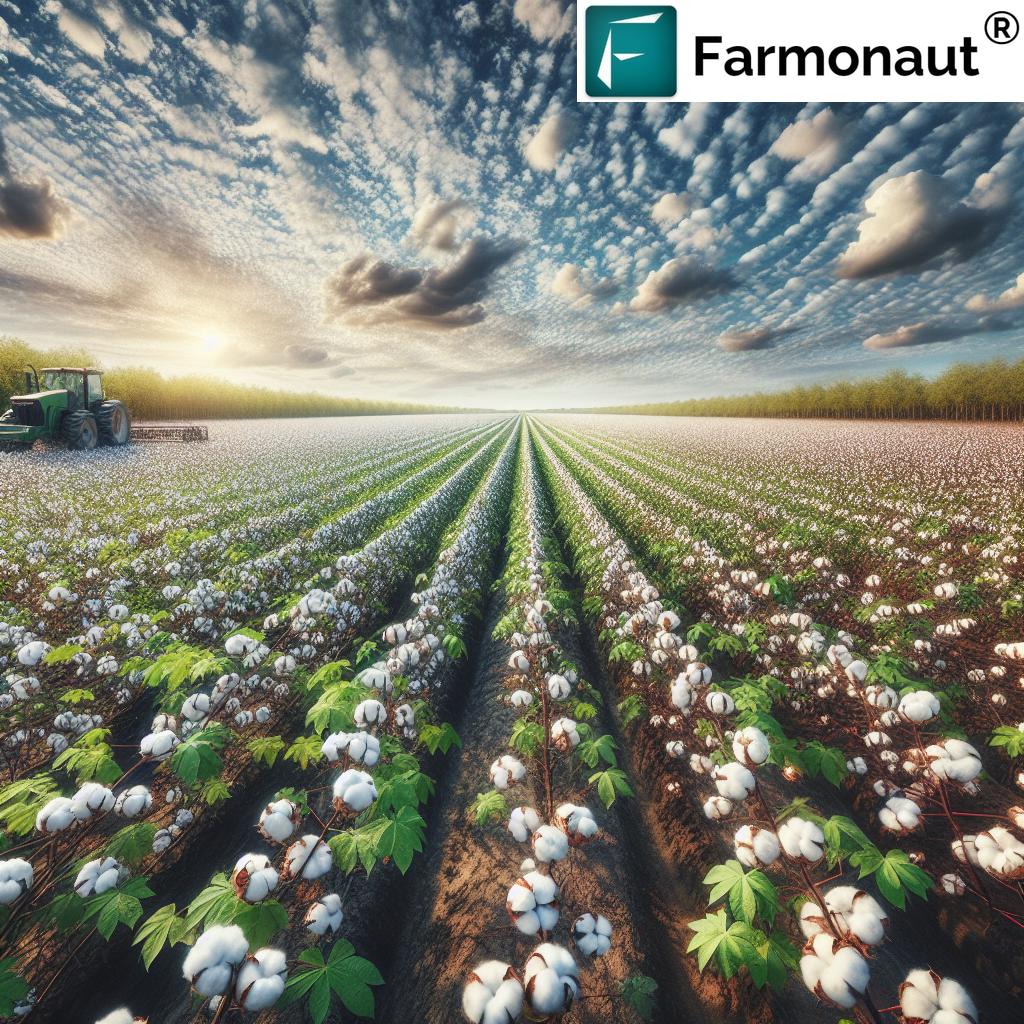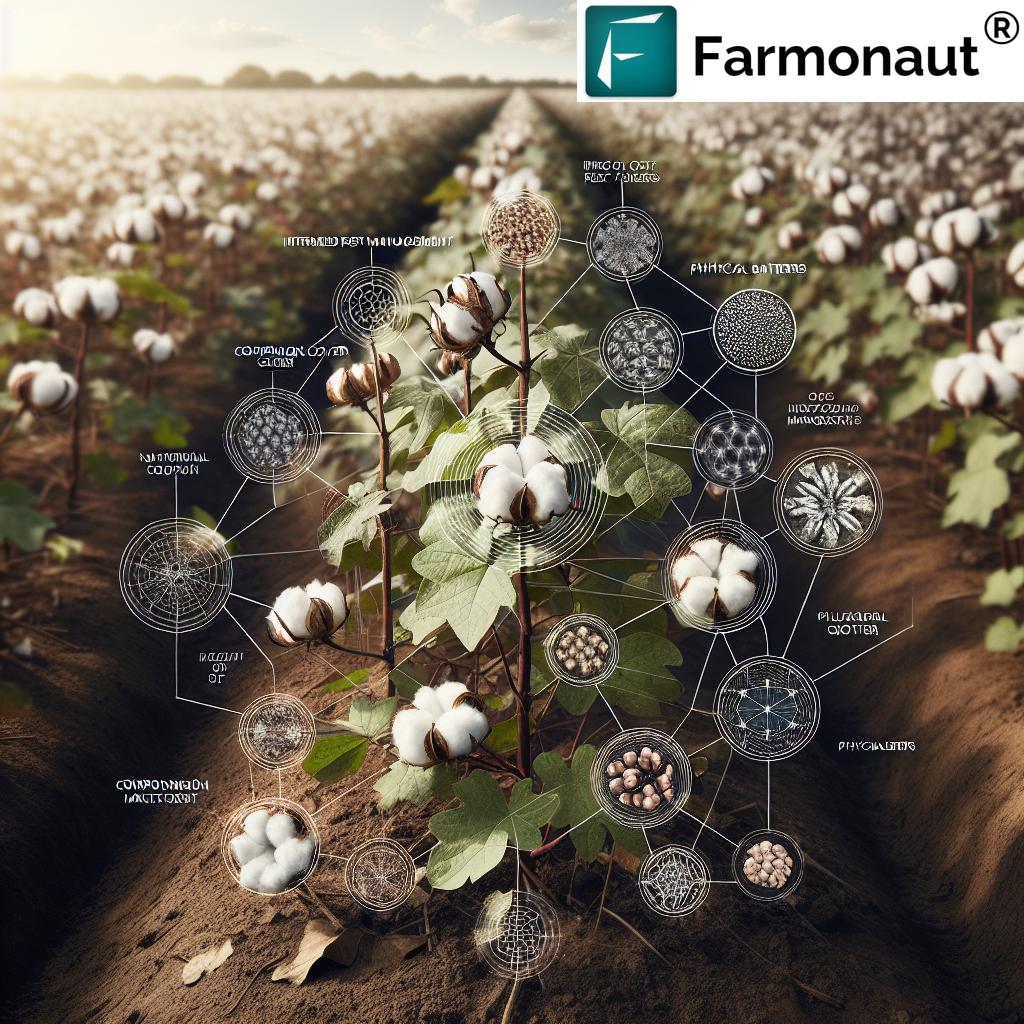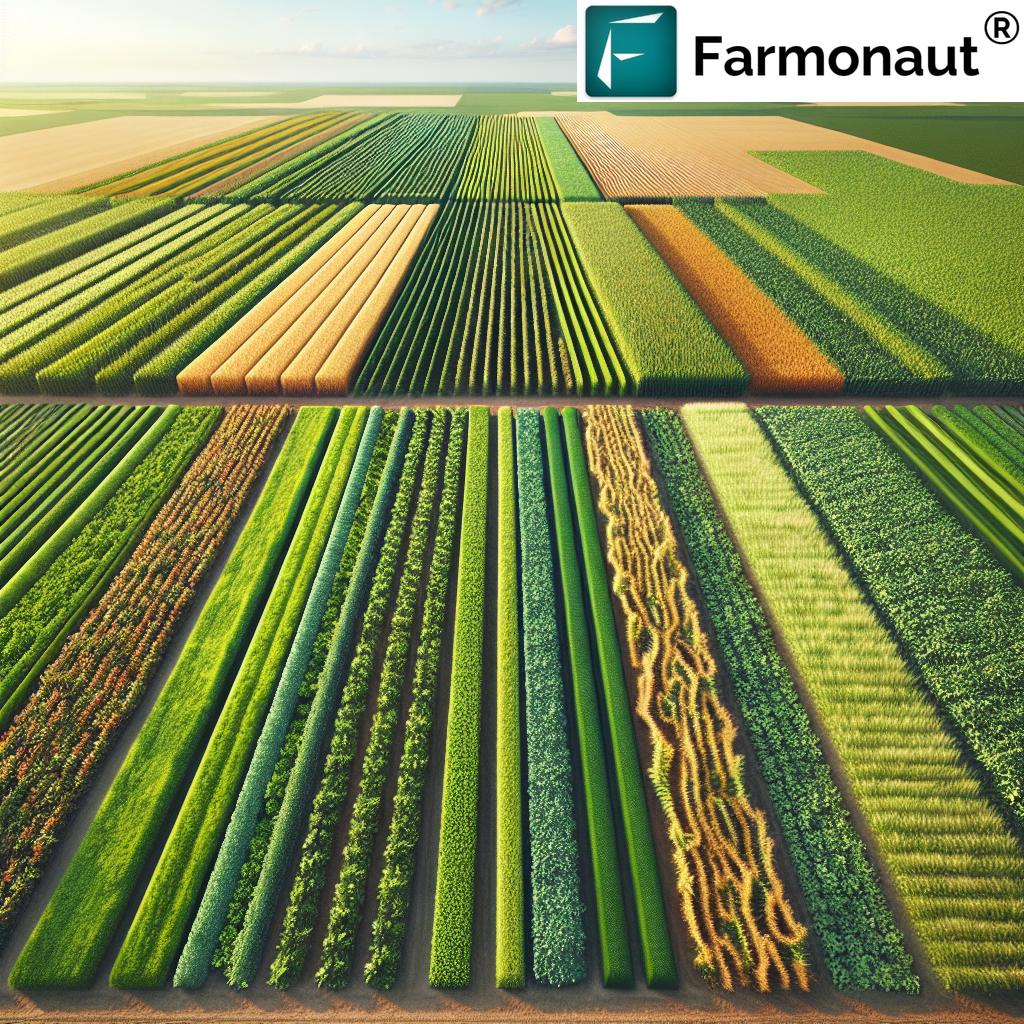Table of Contents
- Introduction: Revealing the Secrets of Modern Cotton Farming
- Historical Overview: The Roots of Cotton Farming
- Global Cotton Production and Trade
- Cotton Farming Practices: From Planting to Harvesting
- Sustainable Cotton Cultivation: Innovations & Practices
- Comparative Trends Table: 7 Shocking Innovations in Cotton Farming
- Technological Advancements in Cotton Agriculture
- Economic Impact of Cotton Farming
- Environmental Challenges in Cotton Farming
- Farmonaut: Powering the Future of Precision Cotton Farming
- FAQ: Cotton Farming Practices & Sustainability
- Conclusion: The Future of Cotton Farming
“Over 75% of global cotton farms now use precision agriculture techniques to boost yields and conserve resources.”
Cotton Farm Secrets: 7 Shocking Trends Revealed!
Introduction: Revealing the Secrets of Modern Cotton Farming
Cotton farming is far more than an agricultural practice—it’s a global engine for textiles, trade, and technology. With major producers like India, China, the United States, and Brazil shaping the industry, cotton cultivation has evolved from ancient manual labor to a field of high-tech innovation and sustainability focus. As cotton continues to be a primary raw material for textiles and countless other products, understanding today’s cotton farming practices, the drive for sustainable cotton cultivation, and emerging technological advancements in cotton agriculture is key to grasping its vital role in our economy and environment.
In this comprehensive guide, we’ll explore the journey from ancient civilizations to digital precision agriculture, cotton irrigation techniques, integrated pest management in cotton, the economic impact of cotton farming, and the most stunning trends shaping yields, soil health, and global cotton production today. Let’s unravel the shocking secrets behind the world’s favorite crop!
Historical Overview: The Roots of Cotton Farming
Our story of cotton starts with the dawn of civilization. From ancient Africa, Asia, and the Americas, cotton’s journey as a crop and textile fiber played a foundational role in shaping societies. Archaeologists have traced its use back to Huaca Prieta, Peru (circa 6000 BCE), where woven cotton fabrics reveal a sophisticated understanding of natural resources.
By the 18th century, cotton was a staple in the economies of the Southern states of the United States, powering both economic growth and the rise of global cotton exporters. The invention of the cotton gin in 1793 marked a turning point—separating fibers from seeds with mechanical efficiency, it drastically increased yields and fed Europe’s growing demand for raw material in textiles.
Fast forward to today: cotton farming draws on millennia-old wisdom and high-tech innovation, adapting continually to meet global production needs and environmental challenges alike.
Global Cotton Production and Trade: Key Producers, Exporters, and Trends
The importance of cotton production spans continents and economies. According to the latest data, global cotton production hit approximately 69.7 million tonnes in 2022. India, China, and the United States remain world leaders in both quality and volume, with each adapting to evolving farming practices and international demand.
- India: Leading in acreage and a pivotal player in sustainable cotton cultivation and regenerative soil management.
- China: Blending ancient wisdom with modern mechanization; rapid adoption of technological advancements in cotton agriculture.
- United States: Famed for mechanized harvesting and being historically the largest exporter.
- Brazil: A fast-growing global cotton exporter, recently overtaking U.S. export volumes—a testament to advanced farming techniques and large-scale sustainable agronomy.
With shifting trade dynamics—like the recent surge of Brazil’s exports and market competition—the cotton economy is more interconnected than ever. Understanding where cotton is grown, how it’s traded, and by whom is central to optimizing future production and benefiting millions worldwide.
Cotton Farming Practices: From Planting to Harvesting
The Core Stages of Cotton Cultivation
Transitioning from history to hands-on practice, let’s examine how cotton farming practices have transformed traditional agriculture into a data-driven, eco-conscious industry. Modern cotton cultivation is a carefully orchestrated process with clear stages:
- Planting: Sowing cotton seeds in spring when soil temperatures reach at least 18°C (64°F).
Key consideration: Optimal seed depth and spacing, often now managed via precision planting technology to enhance uniformity and minimize resource wastage. - Growth: Cotton plants thrive under full sunlight with moderate rainfall. Innovations in irrigation techniques safeguard crops in semi-arid regions.
- Flowering and Pollination: White/pinkish flowers bloom, signaling the reproductive phase. The transformation into mature bolls follows successful pollination—critical for maximizing yields.
- Harvesting: Once bolls naturally split open—revealing fluffy white fibers—the harvest begins. In India and many regions, both manual and mechanical picking coexist, while the United States and Brazil are pioneers of large-scale mechanical harvesting for efficiency and yield maximization.
These stages are tightly linked with evolving best practices in tillage, water conservation, and the reduction of synthetic input usage, setting the stage for long-term sustainability.
Sustainable Cotton Cultivation: Innovations & Practices
As demand for ethical and eco-friendly textiles grows, sustainable cotton cultivation is reshaping the industry. The modern movement seeks to balance commercial yields with the health of soils, water bodies, and surrounding ecosystems. Here’s how leading cotton producing countries are addressing this need:
- Water Management & Cotton Irrigation Techniques: Since cotton is a notoriously water-intensive crop, precision irrigation—using soil moisture sensors, drip systems, and satellite-based monitoring—now enables farmers to optimize water usage and minimize waste. This is especially crucial in arid zones across India and the Southern United States.
- Soil Health in Cotton Farming: Rotational crop planning, the use of cover crops, and minimal tillage help maintain soil fertility and structure. In Brazil’s Cerrado and India’s Deccan plateau, deeper-rooted crops are planted in alternate seasons to break pest cycles and reduce erosion.
- Integrated Pest Management in Cotton (IPM): Biological pest controls (like ladybirds preying on aphids), crop diversity, precision-sprayed inputs, and remote pest monitoring all combine to reduce pesticide use—protecting pollinators and local food chains.
- Carbon Sequestration & Regenerative Agriculture in Cotton: Adoption of conservation tillage, permanent ground cover, and agroforestry in key regions like Brazil, the U.S., and parts of India helps farms become net carbon sinks—offsetting emissions while boosting soil health.
- Fair Labor & Social Programs: Initiatives like the Better Cotton Initiative (BCI) promote ethical labor and equitable profit-sharing, improving both livelihoods and rural economies.
The result? Resilient cotton farms that yield better fiber quality with a fraction of the historical environmental burden.
“Sustainable cotton farming practices have increased soil health by up to 30% in major producing countries since 2015.”
Comparative Trends Table: 7 Shocking Innovations in Cotton Farming
Below is a comparative table highlighting the biggest trends reshaping cotton agriculture across the globe. These innovations drive both environmental and economic gains, with data sourced from recent studies and field reports. The focus is on adoption years, impact on yield, soil health, and regions leading the charge.
| Trend / Innovation | Year of Adoption (Est.) | Impact on Yield (% Increase, Est.) |
Soil Health Impact | Geographical Adoption |
|---|---|---|---|---|
| Precision Agriculture (Satellite, Sensors, AI Tools) | 2010–Present | Up to 25% | Better nutrient balance, reduced compaction | US, India, Brazil, China |
| Drought-resistant/GM Seeds | 2012–Present | 10–20% | Deeper roots, stable organic matter | India, US, China |
| Advanced Cotton Irrigation Techniques (Drip, Sensor-guided) | 2015–Present | 15–20% | Improved moisture regulation | India, Brazil, Africa |
| Integrated Pest Management (IPM) | 2010–Present | 5–10% | Microbial balance, less toxic residue | US, India, China |
| Minimum/No-Tillage Practices | 2016–Present | 6–12% | Protects structure, boosts organics | US, Brazil, Australia |
| Cover Cropping & Crop Rotation | 2012–Present | 5–8% | Reduces erosion, increases organics | Brazil, India, US |
| Blockchain-based Traceability | 2020–Present | Enables premium pricing | Increases sustainable certifications | Global, Textile/Fashion Sectors |
*Data based on published research, major industry reports, and leading agricultural technology sources. Impacts are approximate and subject to farm size, local climate, variety, and management style.
Technological Advancements in Cotton Agriculture
Precision, Data, and Digital Insights for Cotton Farms
We stand at a turning point where technological advancements are not just improving yields—they’re transforming entire farming systems:
- Precision Agriculture Platform (Satellite, AI, Sensors): Leveraging real-time imagery and analytics, farmers can monitor field health, detect disease/pest outbreaks early, and fine-tune fertilizer and irrigation inputs. Farmonaut, for example, delivers actionable insights via mobile and web apps, making affordable satellite-based farm management accessible to all sizes of agriculture, from smallholders in India to large plantations in Brazil and the US.
- Genetically Modified (GM) Cotton & Drought-Resistant Seeds: Engineered varieties offer resistance to bollworms and tolerances to herbicides and dry spells. This is crucial in crop insurance risk assessments, as it lowers the odds of catastrophic crop failure due to pests or adverse weather.
- Regenerative Agriculture in Cotton: New methods like planting legume cover crops, rotating cotton with soy or maize, and using permanent ground cover regenerate soils and sequester atmospheric carbon—driving carbon footprint reductions.
- Blockchain-based Product Traceability: Via blockchain traceability solutions, brands and farmers alike can certify the entire journey of cotton, from field to finished textile, providing transparency and building consumer trust—increasingly crucial in premium/luxury segments.
These innovations are democratizing access to precision agriculture, making advanced resource management and sustainable certification possible for all.
Economic Impact of Cotton Farming
How Cotton Drives Growth, Trade & Rural Prosperity
Cotton is the economic heartbeat for millions of farmers across major producing states and countries. Its significance as a raw material for textile mills and as a cash crop can’t be overstated:
- Employment & Livelihood: Cotton underpins rural jobs throughout India, Africa, Brazil, and the cotton belt in the US. It supports not just farm families but entire local economies—ginners, transporters, textile workers, and more.
- Global Trade Dynamics: With intense demand from mills in China and Vietnam, the exporter nations—US, Brazil, West Africa—enjoy lucrative foreign earnings. Volatility in global cotton prices does pose challenges but also incentivizes investment in innovative practices and risk management.
- Socioeconomic Sustainability: Programs like BCI fuel local development by channeling resources into education, health, and infrastructure. Through technology, traceable supply chains, and digital advisory solutions like those from Farmonaut, smallholder inclusion rises, allowing more to gain from sustainable yields and climate resilience.
By combining tradition with innovation, countries such as India and Brazil are cementing their status as essential cogs in the ever-spinning global cotton machine.
Environmental Challenges in Cotton Farming
Recognizing and Overcoming Ecological Risks
Despite advances, cotton cultivation remains associated with significant environmental challenges:
- Water Usage: Overreliance on irrigation stresses major river basins—e.g., India’s Deccan and Gujarat states, and parts of Texas, USA. Satellite monitoring now helps farmers optimize water use and reduce local shortages.
- Pesticide Use: Historic dependence on agrochemicals harmed wildlife and human health, while also driving resistance among pests. Today, integrated pest management in cotton is key to minimizing pesticide usage without sacrificing productivity.
- Soil Degradation: Conventional tillage and continuous monoculture reduce soil fertility and increase erosion. Modern cover cropping, crop rotations, and no-till practices are rebuilding soil health in India, Brazil, and other leader regions.
- Climate Impact: Cotton’s large acreage means its greenhouse gas footprint is significant. Carbon footprint monitoring and adoption of regenerative practices are the way forward.
The future of cotton depends on rapidly scaling sustainable solutions while addressing threats proactively.
Farmonaut: Powering the Future of Precision Cotton Farming
As cotton farming enters a new era, Farmonaut is at the forefront of integrating satellite, AI, and blockchain into every facet of cotton cultivation. Here are ways in which Farmonaut’s technology suite enables farmers and agribusinesses to thrive:
-
Satellite-based Crop Health Monitoring:
With NDVI analysis, soil moisture readings, and disease/pest detection, Farmonaut provides actionable data to help farmers reduce water and fertilizer usage, enhance yields, and sustain soil health for years to come—thus putting sustainable cotton cultivation within every farmer’s reach.
-
AI-Powered Advisory – Jeevn AI System:
Farmonaut’s smart advisory delivers real-time recommendations on best farming practices, irrigation scheduling, weather alerts, and more—empowering both smallholders and large estates with data-driven decisions.
-
Blockchain-enabled Product Traceability:
Want proof that your textiles are made from sustainable cotton? Farmonaut’s product traceability suite builds transparent, fraud-proof records, from cotton field through every step of the supply chain to store shelves—helping brands and farmers earn trust and access premium markets.
-
Carbon Footprinting Tools:
As climate compliance becomes vital, carbon footprint tracking from Farmonaut enables data-driven emission reductions that can unlock carbon credits and align farms with upcoming regulations.
-
Fleet and Resource Management:
For agribusinesses, fleet management solutions optimize logistics, reduce downtime, and streamline the flow from field to gin.
-
Financing & Insurance Access:
Automated verification tools speed up crop loan and insurance claims, benefiting all parties with higher accuracy and lower fraud.
-
Scalable Platform:
Accessible via web & mobile apps, Farmonaut’s services scale from small-holder farms to multinational agribusinesses and government projects. Open API access (API, Developer Docs) ensures easy integration and widespread adoption.
Farmonaut’s unique subscription model ensures affordability and continuous support for every level of cotton production—from small plots in India to the vast plantations of Brazil.
Ready to transform your cotton farm with world-class precision ag tools? Explore Farmonaut’s mobile-friendly app now or visit our large-scale farm management page for full details on monitoring, advisory, and administration.
FAQ: Cotton Farming Practices & Sustainability
Q1: What are the most important sustainable cotton farming practices?
A: Water-efficient irrigation, crop rotation, reduced tillage, cover cropping, and integrated pest management are key. Together, they optimize yields while preserving natural resources.
Q2: How does Farmonaut help cotton farmers increase yields and income?
A: Through real-time satellite and AI-powered insights, farmers identify field issues early, optimize inputs, reduce costs, and track farm-to-market transparency—boosting both yields and brand value.
Q3: Why is soil health so critical for cotton production?
A: Healthy soil ensures the steady supply of nutrients, water retention, and pest resilience—producing better cotton quality and sustained yields across seasons.
Q4: Where does India stand in global cotton exports and sustainability?
A: India is one of the world’s top cotton producers and an innovator in sustainable farming, with initiatives focusing on water-saving irrigation and regenerative agriculture, bolstered by technology adoption.
Q5: How is blockchain traceability transforming the textile sector?
A: Blockchain records each step of cotton’s journey, preventing fraud and assuring consumers of environmental and ethical standards. This drives demand for sustainably sourced textiles globally.
Q6: What are the major challenges facing future cotton farming?
A: Scarcity of water, pesticide resistance, climate volatility, and falling prices are big hurdles. Embracing precision agriculture and regenerative practices is the best way to future-proof cotton farms.
Conclusion: The Future of Cotton Farming
The secrets behind today’s most successful cotton farms are out: from the fields of India to the gins of Brazil, innovative minds and advanced technology are driving a sustainable revolution. As precision agriculture, regenerative practices, and digital traceability become mainstream, cotton is set to remain an economic and ecological cornerstone.
Solutions offered by trailblazers like Farmonaut are democratizing access to the best of agricultural advancements. By empowering farmers with data, modernizing irrigation and pest management, and ensuring transparency from field to fabric, we’re building a cotton industry that is as reliable as it is resilient.
Whether you’re a farmer, agribusiness, policymaker, or conscious consumer, now is the perfect time to support cotton’s transition towards a more sustainable, tech-enabled future. Stay informed, stay ahead, and let’s grow together—responsibly!















